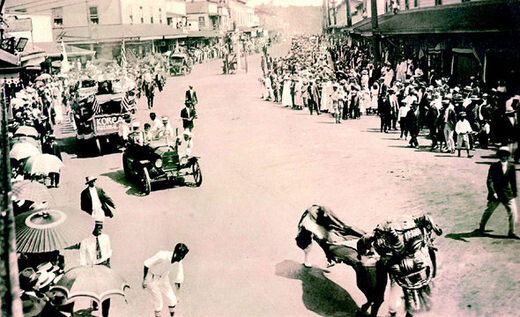hankyoreh
Links to other country sites 다른 나라 사이트 링크
Diary entry reveals Japanese cover-up of massacre

Proof that widely publicized details surrounding "Jeamni Incident," a massacre of Korean civilians during the March First Independence Protests that began on March 1, 1919 and lasted for months nationwide, were in fact part of an official colonial Japanese cover-up has been discovered by the Japanese newspaper Asahi Shimbun.
The newspaper discovered the evidence in the diary of the commander of military forces in Japanese-ruled Korea (1910-45).
Jeamni, or Jeam-ri (also known as Cheam-ni or Cheam-ri in English language records), is a small village in what is now part of Hwaseong City, Gyeonggi Province. It was the site of an incident which took place on April 15, 1919 when Japanese soldiers in a vengeful mood because of the independence protests locked 29 civilians, including children, in a church building and burned it to the ground, killing all inside.
In his diary, commander Taro Utsunomiya wrote of the incident that it would "hurt the (Japanese) empire to "deal with the matter simply and treat the facts as facts," because "that would mean (Japanese forces) were engaged in cruel massacre and arson."
Referring to how the Japanese colonial authorities decided to spin the truth of what happened, Utsunomiya said he "discussed the matter with officials, and we finished our meeting at midnight after deciding to say they were killed because they resisted us, and we decided against admitting the arson and massacre."
In his next entry, Utsunomiya writes that he had decided to punish the lieutenant behind the massacre in the form of thirty days’ disciplinary confinement, because "aspects of the way (the protest at Jeamni) was put down were inappropriate."
News records confirm that the officer was confined for thirty days.
The diary also reveals that Utsunomiya took an active interest in trying to win over Koreans who were resisting Japanese rule, meeting on several occasions with Korean activists operating media critical of the Japanese colonial government to exchange views. His diary entry on March 20, a time when the March First Independence Protests were still going strong, says that he approached leaders of the indigenous religion Cheondo-gyo, believers of which, along with Protestants, played a leading role in the demonstrations, and tried to convince them to stop their resistance. In a letter to Japan’s army chief of staff dated May 1, he wrote that colonial Korea "will need to be granted autonomy in the future."
Academics are calling for renewed inquiry into those behind the massacre and the colonial government’s moves to cover up what happened.
Meanwhile, the city of Hwaseong announced February 28 that it plans to spend 7 billion won (US$7.4 million) to turn the site of the massacre into a memorial "pan-religious holy site" by 2010 with participation from Protestant and Cheondo-gyo organizations.
Please direct questions or comments to [englishhani@hani.co.kr]
Editorial・opinion
![[Column] Season 2 of special prosecutor probe may be coming to Korea soon [Column] Season 2 of special prosecutor probe may be coming to Korea soon](https://flexible.img.hani.co.kr/flexible/normal/500/300/imgdb/original/2024/0426/3317141030699447.jpg) [Column] Season 2 of special prosecutor probe may be coming to Korea soon
[Column] Season 2 of special prosecutor probe may be coming to Korea soon![[Column] Park Geun-hye déjà vu in Yoon Suk-yeol [Column] Park Geun-hye déjà vu in Yoon Suk-yeol](https://flexible.img.hani.co.kr/flexible/normal/500/300/imgdb/original/2024/0424/651713945113788.jpg) [Column] Park Geun-hye déjà vu in Yoon Suk-yeol
[Column] Park Geun-hye déjà vu in Yoon Suk-yeol- [Editorial] New weight of N. Korea’s nuclear threats makes dialogue all the more urgent
- [Guest essay] The real reason Korea’s new right wants to dub Rhee a founding father
- [Column] ‘Choson’: Is it time we start referring to N. Korea in its own terms?
- [Editorial] Japan’s rewriting of history with Korea has gone too far
- [Column] The president’s questionable capacity for dialogue
- [Column] Are chaebol firms just pizza pies for families to divvy up as they please?
- [Column] Has Korea, too, crossed the Rubicon on China?
- [Correspondent’s column] In Japan’s alliance with US, echoes of its past alliances with UK
Most viewed articles
- 1[Column] Season 2 of special prosecutor probe may be coming to Korea soon
- 2‘We must say no’: Seoul defense chief on Korean, USFK involvement in hypothetical Taiwan crisis
- 3Is N. Korea threatening to test nukes in response to possible new US-led sanctions body?
- 4Division commander ordered troops to enter raging flood waters before Marine died, survivor says
- 5Amnesty notes ‘erosion’ of freedom of expression in Korea in annual human rights report
- 6Is Japan about to snatch control of Line messenger from Korea’s Naver?
- 7No good, very bad game for Korea puts it out of Olympics for first time since 1988
- 8[Editorial] Korea’s surprise Q1 growth requires objective assessment, not blind fanfare
- 9N. Korean delegation’s trip to Iran shows how Pyongyang is leveraging ties with Moscow
- 10Korea’s 1.3% growth in Q1 signals ‘textbook’ return to growth, says government